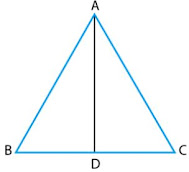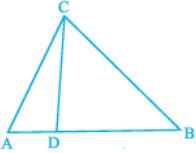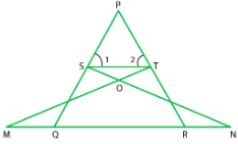Chapter 6 Triangles NCERT Exemplar Solutions Exercise 6.3 Class 10 Maths

Chapter Name | NCERT Maths Exemplar Solutions for Chapter 6 Triangles Exercise 6.3 |
Book Name | NCERT Exemplar for Class 10 Maths |
Other Exercises |
|
Related Study | NCERT Solutions for Class 10 Maths |
Exercise 6.3 Solutions
Short Answer Questions
1. In a ΔPQR, PR2 - PQ2 = QR2 and M is a point on side PR such that QM ⊥ PR.
Prove that :
QM2 = PM × MR.
Solution
In ∆PQR,
PR2 = QR2 and
QM ⊥ PR
Using Pythagoras theorem, we have,
PR2 = PQ2 + QR2
∆PQR is right angled triangle at Q.
From ∆QMR and ∆PMQ, we get,
∠M = ∠M
∠MQR = ∠QPM [each 90°-∠R]
So, using the AAA similarity criteria,
We have,
∆QMR ∼ ∆PMQ
Also,
Area of triangles = 1/2 × base × height
So, by property of area of similar triangles,
QM2 = PM × RM
Hence proved.
2. Find the value of x for which DE || AB in given figure.
Solution
As given in the question,
DE || AB
Using basic proportionality theorem,
CD/AD = CE/BE
If a line is drawn parallel to one side of a triangle such that it intersects the other sides at distinct points, then, the other two sides are divided in the same ratio. Therefore, we can conclude that, the line drawn is equal to the third side of the triangle.
(x +3)/(3x + 19) = x/(3x + 4)
⇒ (x + 3)(3x + 4) = x(3x + 19)
⇒ 3x2 + 4x + 9x + 12 = 3x2 + 19x
⇒ 19x - 13x = 12
⇒ 6x = 12
⇒ x = 2
3. In figure, if ∠1 =∠2 and ∆ NSQ ≅ ∆MTR, then prove that ΔPTS ~ ΔPRQ.
Solution
As given in the question,
ΔNSQ ≅ ΔMTR
∠1 = ∠2
As,
∆NSQ = ∆MTR
So,
SQ = TR ...(i)
Also,
∠1 = ∠2
So,
PT = PS ...(ii)
[As, sides opposite to equal angles are also equal]
Using Equation (i) and (ii).
PS/SQ = PT/TR
So,
ST || QR
By converse of basic proportionality theorem, If a line is drawn parallel to one side of a triangle to intersect the other sides in distinct points, the other two sides are divided in the same ratio.
∠1 = PQR and∠2 = ∠PRQ
Now, In ∆PTS and ∆PRQ.
∠P = ∠P [Common angles]
∠1 = ∠PQR (proved)
∠2 = ∠PRQ (proved)
∆PTS – ∆PRQ [By AAA similarity criteria]
Hence proved.
4. Diagonals of a trapezium PQRS intersect each other at the point 0, PQ || RS and PQ = 3 RS. Find the ratio of the areas of Δ POQ and Δ ROS.
Solution
As given in the question,
PQRS is a trapezium in which PQ || RS and PQ = 3RS
PQ/RS = 3/2 ...(i)
In ∆POQ and ∆ROS,
∠SOR = ∠QOP [vertically opposite angles]
∠SRP = ∠RPQ [alternate angles]
∆POQ ∼ ∆ROS [by AAA similarity criterion]
Using property of area of similar triangle,
So, the required ratio = 9 : 1.
5. In figure, if AB || DC and AC, PQ intersect each other at the point O. Prove that OA.CQ = OC.AP.
Solution
As given in the question,
AC and PQ intersect each other at the point O and AB||DC.
Using ∆AOP and ∆COQ,
∠AOP = ∠COQ [as they are vertically opposite angles]
∠APO = ∠CQO [since, AB||DC and PQ is transversal, Angles are alternate angles]
So,
∆AOP ∼ ∆COQ [using AAA similarity criterion]
As, corresponding sides are proportional
We have,
OA/OC = AP/CQ
OA × CQ = OC × AP
Hence, Proved.

⇒ (8)2 = AD2 + (4)2
⇒ 64 = AD2 + 16
⇒ AD = √48
⇒ AD = 4√3 cm.
AB/ED = BC/EF = AC/DF
4/6 = BC/9 = AC/12
Now, 4/6 = BC/9
BC = 6 cm
Similarly,
AC/12 = 4/6
⇒ AD AC = 8cm
Perimeter of ∆ABC = AB + BC + AC
= 4 + 6 + 8 = 18 cm
So, the perimeter of the triangle is 18 cm.

DE || BC,
DE = 6 cm and
BC = 12 cm
In ΔABC and ΔADE,
∠ABC = ∠ADE [corresponding angle]
and
∠A = ∠A [common side]
= 62 /122 = 1/4
Taking,
ar(∆ADE) = k, then
⇒ ar(∆ABC) = 4k
Now,
ar(∆ECB) = ar(ABC) - ar(ADE)
= 4k - k = 3k
So,
Required ratio = ar(ADE) : ar(DECB)
= k : 3k
= 1 : 3
So, AB || PQ || DC.

In ∆ABD,
PO || AB
DP/AP = DO/OB ...(i)
In ∆BDC,
OQ || DC
BQ/QC = OB/OD
or, QC/BQ = DO/OB ...(ii)
So, from (i) and (ii),
DP/AP = QC/BQ
⇒ 18/AP = 15/35
AP = 42 cm
Also,
AD = AP + PD
= 42 + 18 = 60
So, AD = 60 cm
In ΔPQR, N is a point on PR, such that QN ⊥ PR and PN .

Also,
⇒ x = 12 cm

AC/AD = AB/AC
⇒ 8/3 = AB/8
⇒ AB = 64/3 cm
Also,
AB = BD + AD
⇒ 64/3 = BD + 3
⇒ BD = 55/3 cm

So by AA rule,
AB/DE = BC/EF
⇒ 24/16 = 15/h
⇒ h = 10
Hence, the height of the point on he wall where the top of the ladder reaches is 8 m.
In right angled ∆ABC
AC2 = AB2 + BC2
⇒ (10)2 = AB2 + (6)2
⇒ 100 = AB2 + 36
⇒ AB2 = 100 - 36 = 64
⇒ AB = 8 m
Therefore, the height of the point on the wall where the top of the ladder reaches is 8 m.







